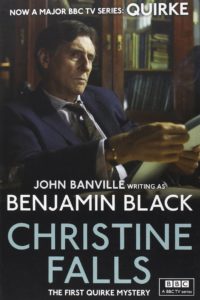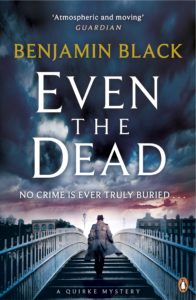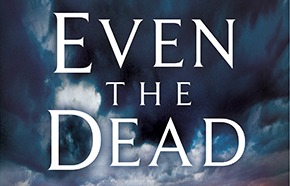Features
Introducing Quirke
My character Quirke was conceived back in the 1990s when a friend of mine in Dublin, Laura Magahy, the ‘onlie begetter’ of the Irish Film Centre, proposed that we should develop a screen drama that would have at its centre the scandalous treatment of unmarried mothers and their babies in the 1950s. We devised a plot outline centred on an influential Dublin family, a Boston-Irish millionaire, and a secret organisation, run by Catholic businessmen with the support of the Church, set up to export ‘illegitimate’ babies for adoption by Catholic families in America.
As with so many such projects, nothing came of it. However, in 2000 I was approached by Tyrone Productions, the film-making branch of the Riverdance company – yes, it was complicated, and  would become more so – who had been approached by RTE, the Irish national television station, and ABC television in Australia, who wished to co-operate on a mini-series set between Ireland and Australia. I offered them the plot outline I had developed with Laura, substituting Australia for America as the destination for the smuggled babies.
would become more so – who had been approached by RTE, the Irish national television station, and ABC television in Australia, who wished to co-operate on a mini-series set between Ireland and Australia. I offered them the plot outline I had developed with Laura, substituting Australia for America as the destination for the smuggled babies.
I was commissioned to write a three-part series, which I called Lost Innocents, with Quirke, a Dublin pathologist, as its protagonist. However, this project also fell through.
A few years later, on the recommendation of my friend John Gray, the philosopher, I began to read Georges Simenon, not the Maigret books, but what Simenon called his romans durs, or ‘hard’ novels. I was immensely impressed – Simenon is without question one of the great literary masters of the twentieth century – and determined to try my hand at something similar. Since in Lost Innocents I had a ready-made story complete with protagonist and cast of characters, I decided to turn the three-hour script into a novel.
That was the origin of the first Quirke novel, Christine Falls.
In that book Quirke – his lack of a first name was my hommage to the great Richard Stark and his compelling main character, Parker – was very tall and broad, with blond hair. His background was murky: an orphan, he had spent his childhood in Carricklea in the West of Ireland, a Church-run industrial school, so-called, which in reality was a junior prison where all sorts of waifs and strays could be conveniently shut away from ‘respectable’ society.  Quirke had been rescued from Carricklea by Judge Garret Griffin, who adopted him and brought him to live with his family in Rathgar, an upper-class suburb of Dublin.
Quirke had been rescued from Carricklea by Judge Garret Griffin, who adopted him and brought him to live with his family in Rathgar, an upper-class suburb of Dublin.
As book succeeded book, Quirke underwent a number of changes, some subtle, some not. I quickly realised that I could not sustain him as a sort of shambling giant, so I laid less and less emphasis on his height and his great girth. Then one day I received a letter from a woman reader, who scolded me for insisting on describing Quirke’s hair as blond, when plainly, she declared, it was brown. How she knew this, I don’t know, but of course she was right, and in subsequent books I took remedial action.
Then, irony of ironies, the BBC proposed turning the first three books into television dramas – all things return, in time – the scripts to be written by Andrew Davies and Conor McPherson. When I heard that Quirke was to be played by that wonderful actor Gabriel Byrne, I knew at once that Quirke would have to undergo another transformation, since inevitably Gabriel’s photograph would be used on paperback covers.
The result is that the Quirke of Even the Dead is a trim and compact figure, blessed with Gabriel’s melancholy good looks. A metamorphosis indeed. But for all that he is still the Quirke that Laura Magahy and I conceived between us – immaculately, so to speak – all those years ago.
1 Comment
Join the discussion
Please note: Moderation is enabled and may delay your comment being posted. There is no need to resubmit your comment. By posting a comment you are agreeing to the website Terms of Use.


Banville/Black is plain wrong to describe Laura Magahy as “onlie begetter” of the Irish Film Centre.
The prime movers or “begetters” were all members of the Irish Film Institute – in particular Luke Gibbons, Kevin Rockett, Ciaran Benson, Niamh O’Sullivan, Donald Taylor Black, Stephanie McBride and David Kavanagh.
In a single stroke Banville/Black has written all these people out of Irish cultural history. Magahy was indeed employed by the institute for a time as one of the project managers in renovating the centre, and went on to manage Temple Bar Properties.
For the actual history of the centre, check out the Irish Film Institute’s own website or blogs, e.g.
http://irishfilminstitute.blogspot.ie/2012/09/from-aspiration-to-reality.html